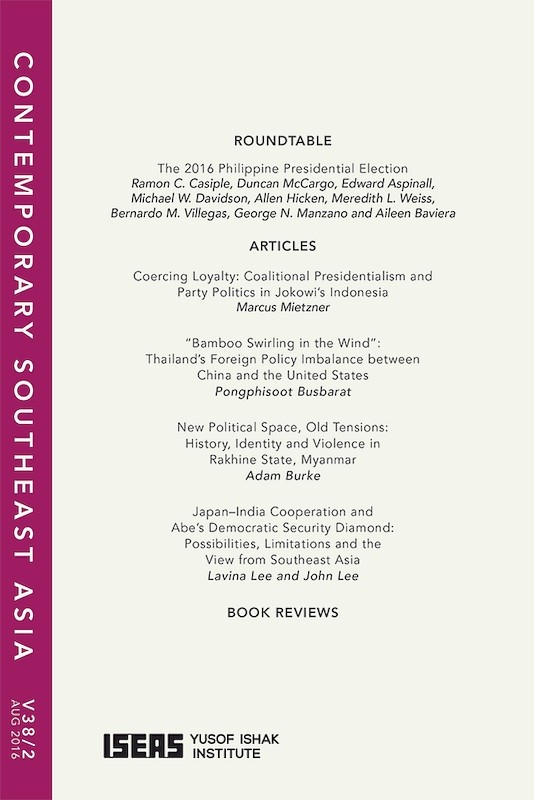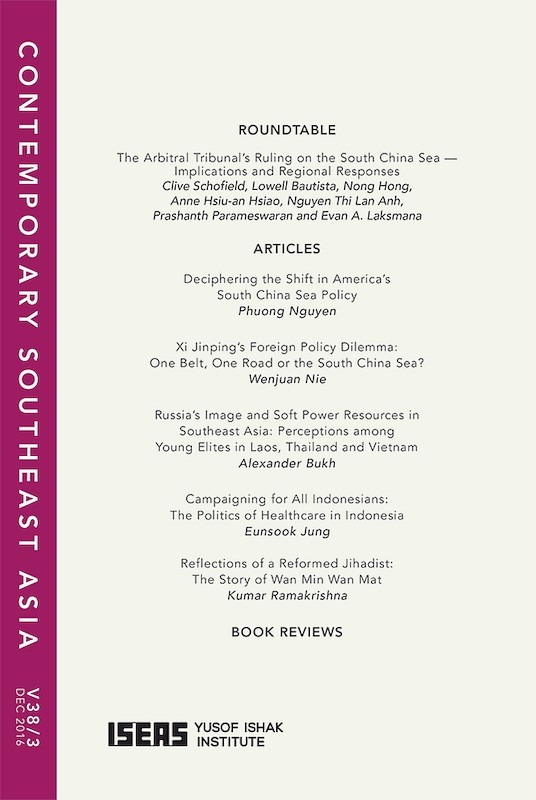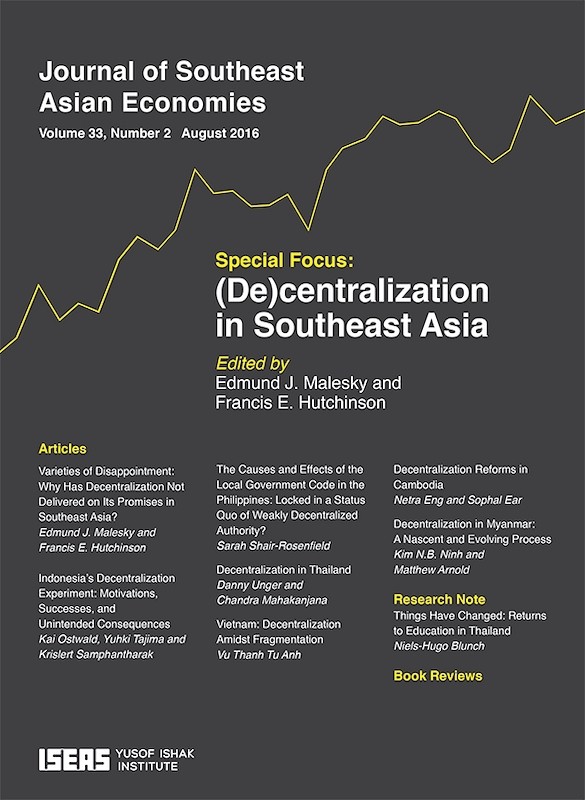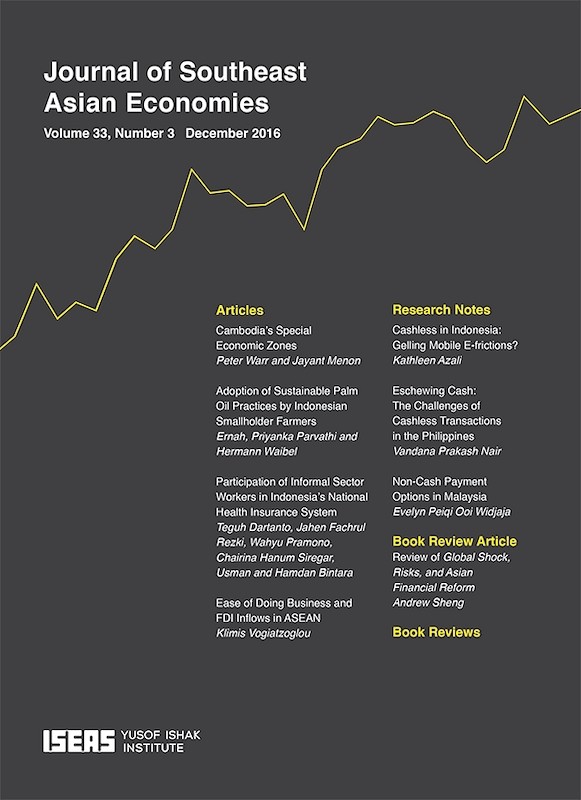Contemporary Southeast Asia Vol. 38/2 (August 2016)

Ian Storey, editor
Date of publication:
August 2016
Publisher:
ISEAS – Yusof Ishak Institute
Number of pages:
160
Code:
CS38/2
About the publication
- Attained impact factor of 0.906 in Social Sciences Citation Index 2017
- Ranked 18th by Google Scholar Metrics 2018 in the Asian Studies and History category
Contents
-
Contemporary Southeast Asia Vol. 38/2 (August 2016)
[Whole Publication, ISSN: 1793284X] -
Preliminary pages
- ROUNDTABLE
-
1. Roundtable: The 2016 Philippine Presidential Election, by Ramon C Casiple, Duncan McCargo, Edward Aspinall, Michael W Davidson, Allen Hicken, Meredith L Weiss, Bernardo M Villegas, George Manzano, Aileen S P Baviera, authors
- ARTICLES
-
2. Coercing Loyalty: Coalitional Presidentialism and Party Politics in Jokowi's Indonesia, by Marcus Mietzner, author see abstract<font face="helvetica, arial, verdana, sans-serif"><span style="font-size: 13px;">Scholars of coalitional presidentialism have focused on the question of how presidents in multi-party systems manage to establish stable governments. Some authors have argued that in the case of Indonesia, post-authoritarian presidents have prioritized inclusivist alliance building, with all parties offered cabinet seats and other rewards in exchange for loyalty. However, as this article demonstrates, President Joko Widodo has opted for a more coercive approach: reactivating power tools not used since the days of Suharto’s autocracy, he intervened in the internal affairs of at least two opposition parties and eventually forced them to declare their support for his administration. This method, while designed to obstruct the anti-democratic agenda of the opposition, has in itself had detrimental effects on Indonesia’s democratic quality.</span></font>
-
3. "Bamboo Swirling in the Wind": Thailand's Foreign Policy Imbalance between China and the United States, by Pongphisoot Busbarat, author see abstract<font face="helvetica, arial, verdana, sans-serif"><span style="font-size: 13px;">This article examines Thailand’s foreign policy posture towards China and the United States since the early 2000s. It argues that Thailand increasingly faces difficulties in maintaining its time-honoured diplomatic tradition of flexibility and pragmatism. The “China factor”, together with domestic developments since the late 1990s, including the rise of nationalistic sentiment among the public and political polarization, have become important determinants in the decision-making process vis-à-vis Thailand’s relations with Washington and Beijing. As a result, compared to other US allies in Asia, Thailand does not always accommodate American policies but, in many circumstances, acts in favour of China instead. This policy posture is not a product of a well-planned strategy, but rather a reaction to the China factor and domestic sensitivities surrounding decision-making. This current stage of Thai foreign policy can be labelled “bamboo swirling in the wind” instead of the conventional “bending with the wind” diplomacy that tends to reflect a better-calculated strategy to balance Great Power influence. </span></font>
-
4. New Political Space, Old Tensions: History, Identity and Violence in Rakhine State, Myanmar, by Adam Burke, author see abstract<font face="helvetica, arial, verdana, sans-serif"><span style="font-size: 13px;">Violence in Rakhine State of Myanmar in 2012 and 2013 caused up to 1,000 deaths and forced the long-term displacement of entire communities. Using evidence from interviews, media coverage and secondary literature, this article explores recent events and considers contextual factors behind the unrest. The conflict is a symptom of long-term historical tensions between Rakhine Buddhists and Muslims, and contemporary political changes that reinvigorated anti-Muslim sentiment across Myanmar. Rigid ethnic classifications that are enshrined in Myanmar’s laws and political system have encouraged territorial attitudes and furthered discrimination against Muslims and others perceived as migrants. This environment generates incentives for local politicians to strengthen group identity and present themselves as the guardians of their electorate. Raised tensions and a background of violence made it easier for Rakhine politicians to promote identity-based voting and to ensure that most Muslim voters in Rakhine State were disenfranchised, paving the way for some local success in the national elections of November 2015. Following the elections, Aung San Suu Kyi’s new government indicated that past policies would continue, disappointing those hoping for rapid change and demonstrating the entrenched nature of Rakhine State’s problems.</span></font>
-
5. Japan-India Cooperation and Abe's Democratic Security Diamond: Possibilities, Limitations and the View from Southeast Asia, by Lavina Lee, John Lee, authors see abstract<font face="helvetica, arial, verdana, sans-serif"><span style="font-size: 13px;">Upon assuming the leadership for the second time in December 2012, Japanese Prime Minister Shinzo Abe called for the formation of a “democratic security diamond (DSD)” to safeguard the maritime commons stretching from the Indian Ocean region to the western Pacific with four of Asia’s most prominent maritime democracies — Australia, India, the United States and Japan — forming the points of the diamond. The Japanese leader explicitly called on these states to join forces to oppose Chinese “coercion” and to defend peace, stability and freedom of navigation within the diamond. The rehashed quadrilateral concept raises a number of interesting issues relevant to the future security environment of the Indo-Pacific, and for Southeast Asia in particular. This article looks at Abe’s idea of the DSD, why Japan has recently advocated for its formation, and why the United States, India and Australia are targeted as the potential members. The article then looks at the Abe government’s greater willingness and capacity to play a meaningful strategic role in East Asia, applied to a DSD context. This is followed by an examination of Japan’s interest in deepening cooperation with India and possibly seeking Indian support for the quadrilateral idea. It then assesses what role India might play and New Delhi’s likely level of interest in joining such a grouping. Finally, the article argues key players in Southeast Asia will remain ambivalent about the prospect of a DSD founded on a burgeoning Japan–India bilateral relationship.</span></font>
- BOOK REVIEWS
-
BOOK REVIEW: The Female Voice of Myanmar: Khin Myo Chit to Aung San Suu Kyi. By Nilanjana Sengupta, by Priscilla Clapp, author
-
BOOK REVIEW: Identity Politics and Elections in Malaysia and Indonesia: Ethnic Engineering in Borneo. By Karolina Prasad, by Arnold Puyok, author
-
BOOK REVIEW: India Rising: Fresh Hope, New Fears. By Ravi Velloor, by Subrata K Mitra, author
-
BOOK REVIEW: Political Institutions in East Timor: Semi-presidentialism and Democratization. By Lydia M. Beuman, by Rui Graça Feijó, author
-
BOOK REVIEW: Electoral Dynamics in Indonesia: Money Politics, Patronage and Clientelism at the Grassroots. Edited by Edward Aspinall and Mada Sukmajati, by Diego Fossati, author
-
BOOK REVIEW: Conflict Resolution and Peacebuilding in Laos: Perspective for Today's World. By Stephanie Phetsamay Stobbe, by Kearrin Sims, author
-
BOOK REVIEW: Meeting China Halfway - How to Defuse the Emerging US-China Rivalry. By Lyle J. Goldstein, by Sam Bateman, author
-
BOOK REVIEW: Three Centuries of Conflict in East Timor. By Douglas Kammen, by Yuji Uesugi, author
-
BOOK REVIEW: The Mekong: A Socio-Legal Approach to River Basin Development. By Ben Boer, Philip Hirsch, Fleur Johns, Ben Saul and Natalia Scurrah, by Richard P Cronin, author






